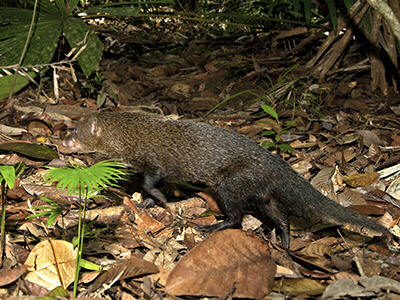
Fig 1

Fig 2

Fig 3

Fig 4

Fig 5
|
Order : CARNIVORA
Family : Herpestidae
Species : Herpestes brachyurus
Head-body length : up to 45 cm
Tail length : up to 25 cm
Weight : up to 2 kg
The Short-tailed Mongoose
(or Water Mongoose) inhabits primary or mature secondary forest, but may
enter adjacent degraded forest, plantations (e.g. Acacia) or
cultivated areas. On mainland Southeast Asia it appears restricted to lowland areas below
~100 metres in
elevation, but in some parts of Borneo, where it may be locally common, it
can be found at higher elevations of 1500 metres or more.
The species is mainly active by day on the forest floor, where it searches for a
range of prey items including small vertebrates and arthropods such as
crabs, spiders, insects etc. It is solitary in habits and territorial. A
study in Krau Wildlife Reserve, Peninsular Malaysia (Jenning et al, 2010)
revealed a mean home range size of 233 hectares for males and 132 hectares
for females.
Its body is slender, its legs are short, and its tail is just over 50% of the
combined length of the head and body. Its head is relatively small and its
snout is pointed.
Its fur is typically blackish to dark brown, with subtle pale brown tinges
and pale brown throat and chin. Geographic variations in fur colour are
documented, although the reasons for this appear largely unstudied.
The Short-tailed Mongoose occurs in Peninsular Malaysia, Sumatra and Borneo.
It may also occur on the Philippine islands of Palawan and Calamian, but
some researchers identify these populations as the
Collared Mongoose. There is an historical record
from Singapore (which may not have been a native animal), but there are no
recent records.
Fig 1 : Short-tailed Mongoose exploring a clear stream in a steep, forested gully.
Fig 2 : This mongoose
was exploring an area of freshwater swamp forest early one morning.
Fig 3 : Traversing a swampy pool in the mid-afternoon sun.
Figs 4 and 5 : Exploring the forest floor during a dry spell.
References :
Duckworth, J.W., Mathai, J., Ross, J. & Wilting, A. 2016. Herpestes
brachyurus. The IUCN Red List of Threatened Species 2016: e.T41610A45206655.
Francis, C.M. 2019. A Field Guide to the Mammals of South-east Asia. Second
Edition. New Holland. 416 pp.
Jenning, A., Zubaid, A. and Veron G. (2010) Home ranges, movements and
activity of the short-tailed mongoose (Herpestes brachyurus) on
Peninsular Malaysia. Mammalia. Volume 74, Issue 1, Pp 43–50.
Payne, J., Francis, C.M., 1998. A Field Guide to the Mammals of
Borneo. The Sabah Society.
|